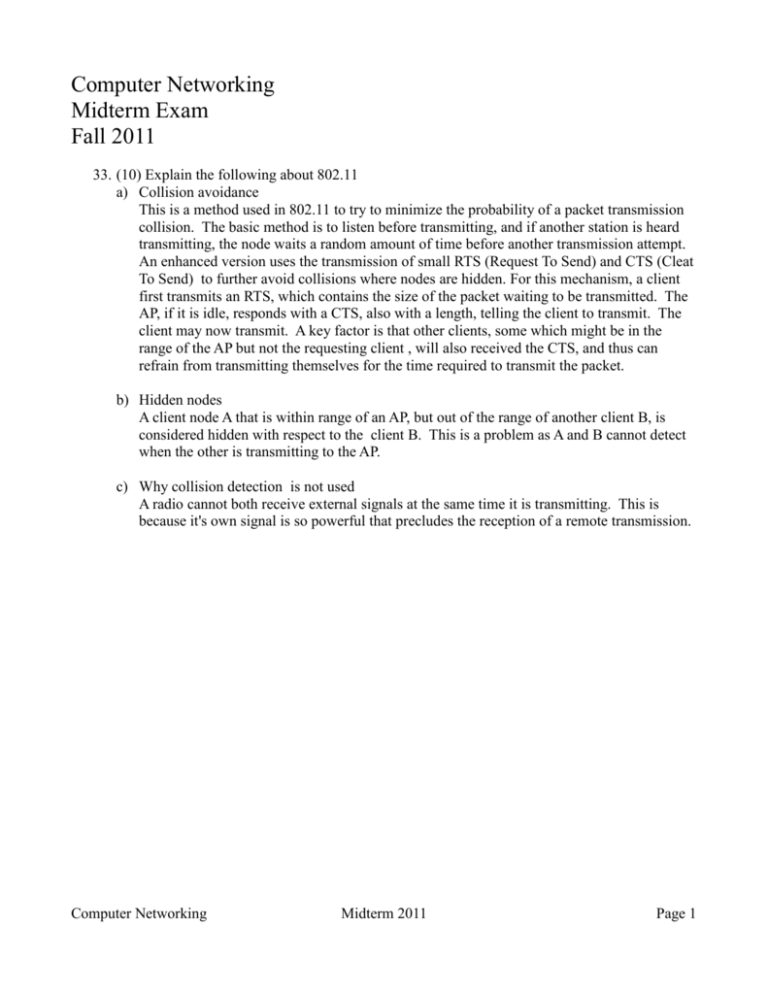NWMidterm2011
advertisement

Computer Networking Midterm Exam Fall 2011 33. (10) Explain the following about 802.11 a) Collision avoidance This is a method used in 802.11 to try to minimize the probability of a packet transmission collision. The basic method is to listen before transmitting, and if another station is heard transmitting, the node waits a random amount of time before another transmission attempt. An enhanced version uses the transmission of small RTS (Request To Send) and CTS (Cleat To Send) to further avoid collisions where nodes are hidden. For this mechanism, a client first transmits an RTS, which contains the size of the packet waiting to be transmitted. The AP, if it is idle, responds with a CTS, also with a length, telling the client to transmit. The client may now transmit. A key factor is that other clients, some which might be in the range of the AP but not the requesting client , will also received the CTS, and thus can refrain from transmitting themselves for the time required to transmit the packet. b) Hidden nodes A client node A that is within range of an AP, but out of the range of another client B, is considered hidden with respect to the client B. This is a problem as A and B cannot detect when the other is transmitting to the AP. c) Why collision detection is not used A radio cannot both receive external signals at the same time it is transmitting. This is because it's own signal is so powerful that precludes the reception of a remote transmission. Computer Networking Midterm 2011 Page 1 34. (10) For the network given below, give the datagram forwarding table for each node. The links are labeled with the relative costs (lower is better); your tables should forward each packet via the lowest-cost path to its destination: 3 C A 8 6 1 B F 2 D E 2 Node A Destination Next Hop A B C C C D C E C F C Node B Destination Next Hop A E B C E D E E E F E Node C Destination Next Hop A A B E C D E E E F F Node D Destination Next Hop A E B E C E D E E F E Node E Destination Next Hop A C B B C C D D E F C Node F Destination Next Hop A C B C C C D C E C F C Computer Networking Midterm 2011 Page 2 For the following problems neatly show complete work for partial credit. 35. (12) Calculate the total time time required to transfer a 1.5-MB file in the following cases, assuming a RTT of 80ns, a packet size of 1 KB data, and an initial 2xRTT of “handshaking” before data is sent: a) The bandwidth is 10Mbps, and the data packets can be sent continuously 100ns per bit. 1.5MB = 1.5*2^20*8=12,582,912bits 10,000,000bps 160ns=.000000160sec . 000000160sec + 12,582,912 /10,000,000sec + .000000040sec = 1.2582912sec + .0000002sec = 1.2582914sec handshaking + time to transmit + propagation delay b) The bandwidth is 10Mbps, but after we finish sending each data packet we must wait one RTT before sending the next. 1KB = 1024*8 = 8,192bits 12,582,912/8,192 = 1,536packets so, to the above (a) time we must wait for ½RTT for each but the last packet: 1.2582912sec + 1535*.000000080 = 1.2582912 + 0.0001228 = 1.258414sec c) The bandwidth is 10Mbps, but after we finish sending each data packet we must wait for a 10 byte ACK packet to be returned. 10Byte = 80bits. 80/10,000,000 = 0.000008sec or 8us to transmit ACK, + .00000004 = 0.000008040sec per ACK 1KB = 8,192 bits 8,192/10,000,000 = 0.0008192 sec to transmit + 0.000008040= 0.00082724 1536*0.00082724 = 1.27064064sec d) Same as c above, but increase the packet size to 5 KB. 5KB=40,960bits 40,960/10,000,000 = 0.004096 sec to transmit + .00000004 = 0.00409604 12,582,912/40,960 = 307.2 or 308 packets 308*(0.00409604+0.000008040)= 1.26405664 sec 36. (12) Suppose a 128-kbps point-to-point link is set up between the Earth and a rover on Mars. The distance from Earth to Mars as this time is approximately 55Gm, and the data travels over the link at the speed of light – 3 x 108 m/s. a) Calculate the minimum RTT for the link. 55,000,000,000/(3*10^8) = 183.333sec times 2 = 366.667sec b) Calculate the delay x bandwidth product for the link. 183.333 * 128,000 = 23,466,624bits 23,466,624/8 = 2,933,328bytes 2,933,328/2^20 = 2.797MB c) A camera on the rover takes a picture of its surroundings and sends these to Earth. How quickly after a picture is taken can it reach Mission Control on Earth? Assume each image is 5 Mb in size. 5*2^20 = 5,242,880bits 5,242,880/ 128,000 = 40.96sec to transmit + ½RTT 40.96 + 183.333 = 224.293sec Computer Networking Midterm 2011 Page 3 37. (12) Suppose you are designing a sliding window protocol for a 1-Mbps point-to-point link to a stationary satellite revolving around earth at an altitude of 3 x 104 km. Assuming each frame carries 1KB of data. a) What is the optimal window size? Propagation delay: 3 * 10^4 * 1000 = 30,000,000 meters 30,000,000 / (3 * 10^8) = 0.1 sec 1,000,000 * .1 = 100,000bits 100,000/(1024*8) = 12.2 or 13 packets each way, or 26 packets round trip. b) Why? This is how many packets that will completely fill the link up and back. c) What will the window size be if the data rate is tripled? 3,000,000 * .1 = 300,000bits 300,000/(1024*8) = 36.62 or 37 packets each way, or 72 packets round trip. 38. (12) Draw a timeline diagram for the sliding window algorithm with SWS = RWS = 3 frames, for the following two situations. Use a timeout interval of about 2 x RTT a) Frame 4 is lost b) Frame 4 to 6 is lost. Computer Networking Midterm 2011 Page 4 do Computer Networking Midterm 2011 Page 5











